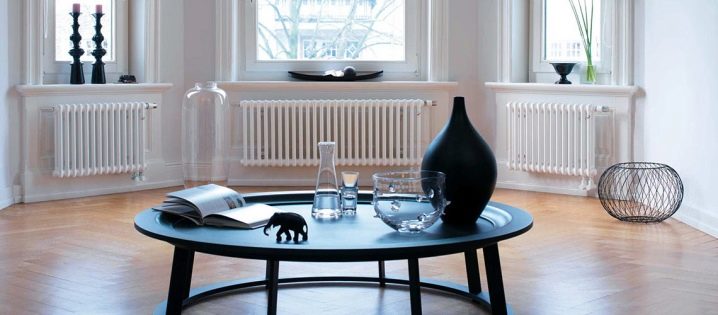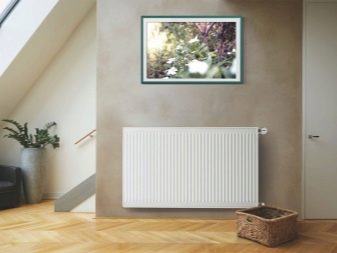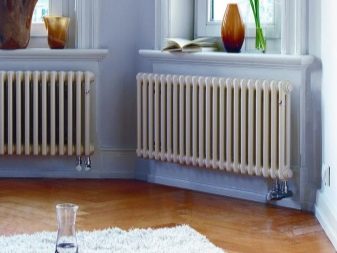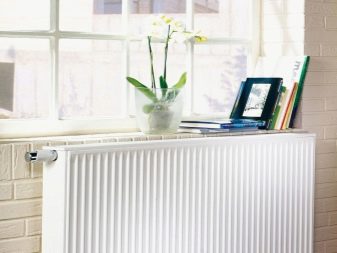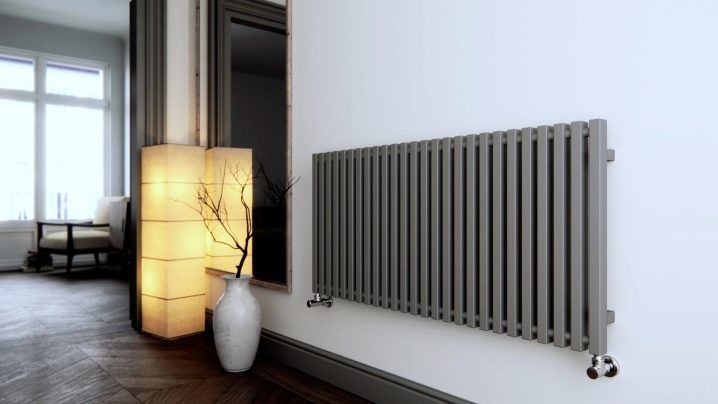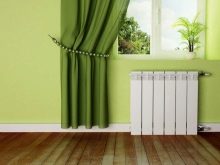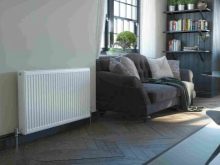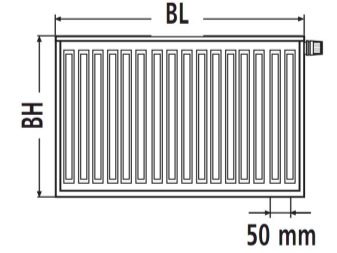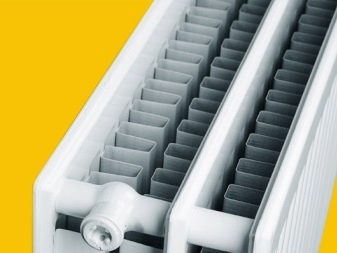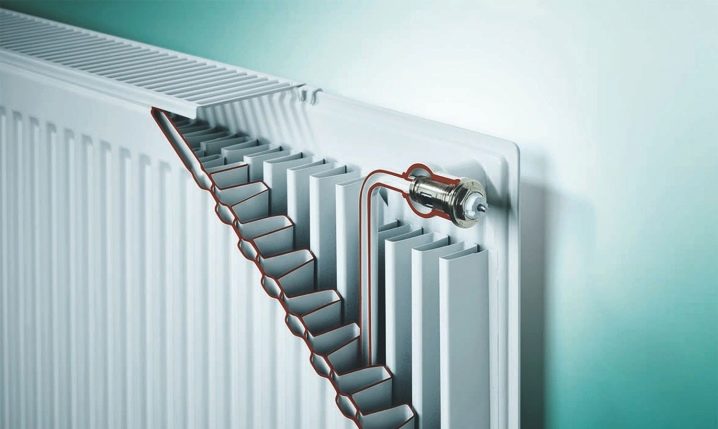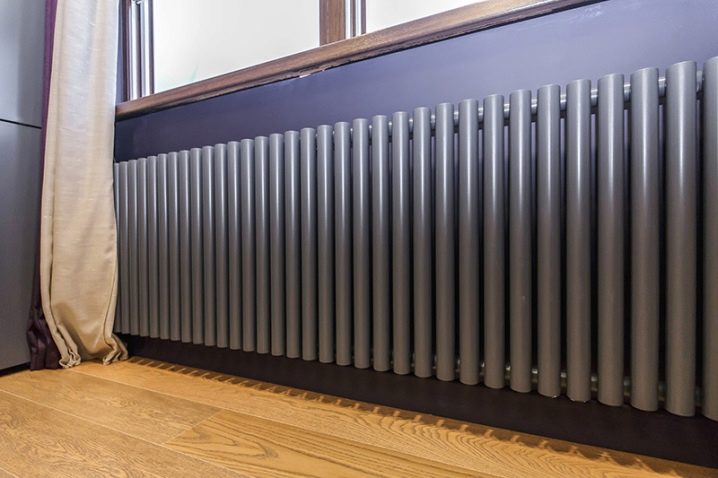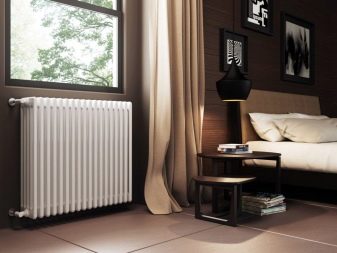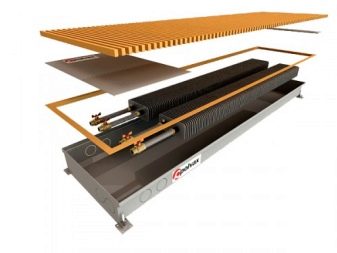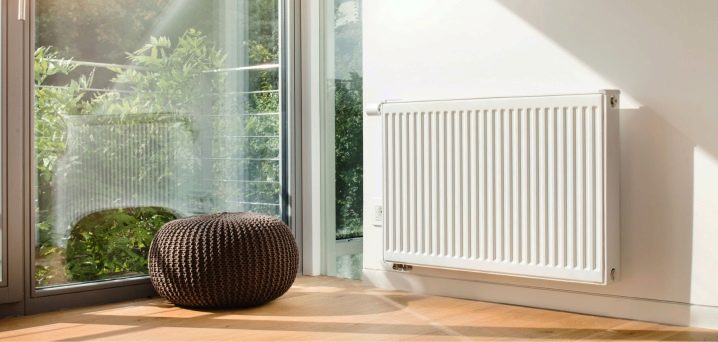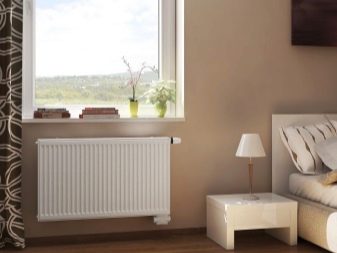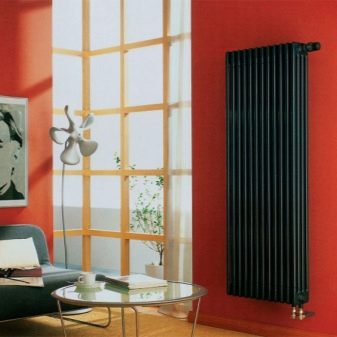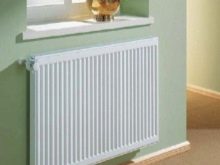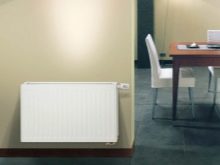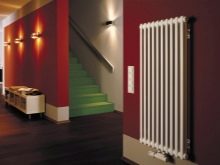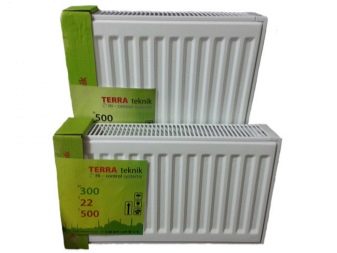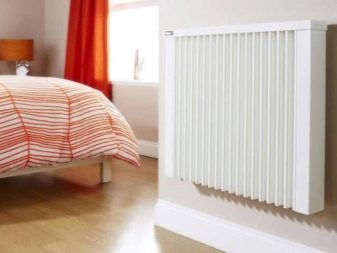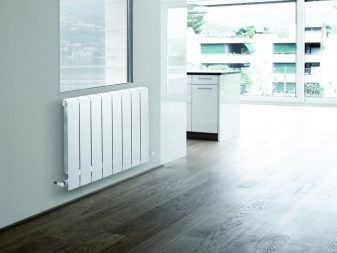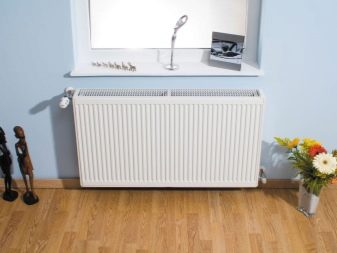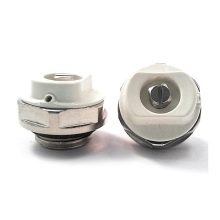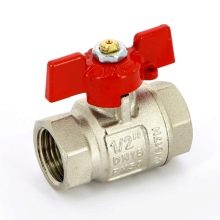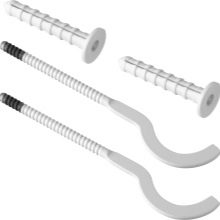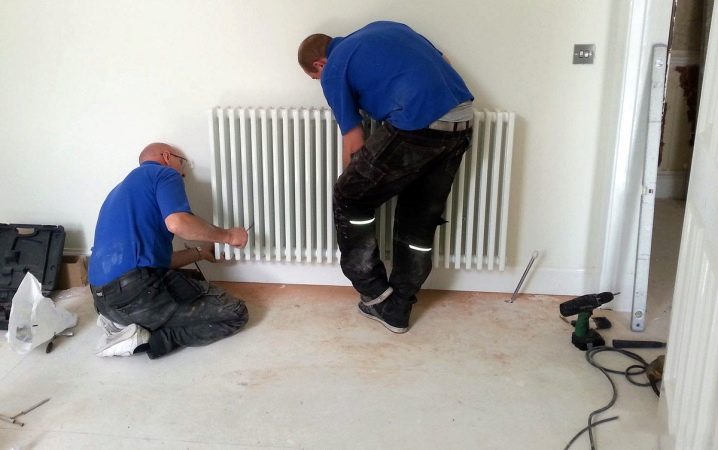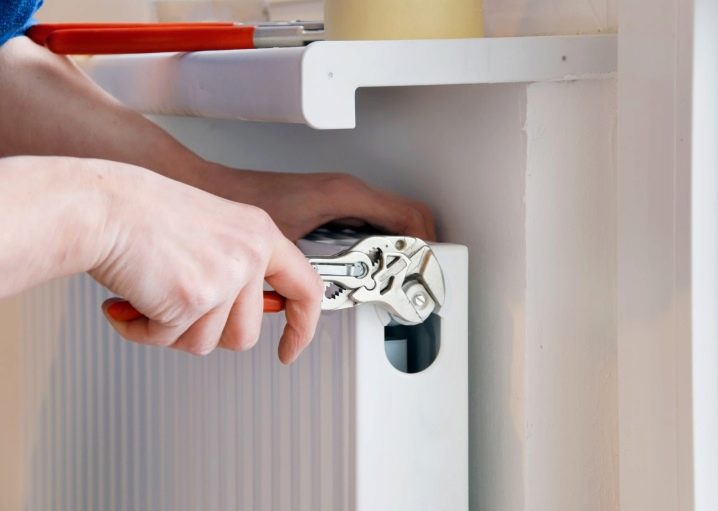Steel heating radiators: features of choice and subtlety of installation

One of the main components of a comfortable stay in the room is its temperature, which is ensured by high-quality batteries. Today, their diversity in the construction market can confuse even a professional. We have to study the technical characteristics and choose from a variety of materials: aluminum, cast iron, copper, bimetal. Despite such a wide choice, steel products remain the most popular type of radiator.
Specifications
A few years ago, the steel cast iron heaters, whose characteristics are higher and their dimensions more compact, replaced the massive cast-iron "accordions".The basis for their production was solid steel, which weighs less, is processed easier, and the heat transfer performance is much higher than that of cast iron. Such products are well heated as small buildings with low water pressure, and large private cottages.
Unfortunately, the installation of such heating structures in apartment buildings is not recommended: the pressure of the water flowing through the pipes from the central boiler room is several times higher than the recommended one, and this can lead to ruptures and leaks. In addition, air may be present in the district heating system along with water, which causes metal corrosion. It must be carefully removed through special descendants.
Depending on the design of the battery of steel can be made in the form of two sheets with grooves, in the form of sheets with imprints, similar to the letter "P", and with U-shaped ribs on the inside. Sheet thickness can vary from 1.2 to 2 mm.
Despite the differences in the structure of the radiator, any such product has the following characteristics:
- high heat transfer;
- high energy saving;
- high efficiency;
- Temperature regulator;
- small weight and volume;
- wide choice of power and design.
Advantages and disadvantages
Like any material, steel can be better in some parameters and worse in others.
If we compare these batteries with other types, we can note a number of advantages.
- In addition to good heat transfer and the ability to regulate the mode using the set thermostat, steel is a material inertia. This means that the material quickly reaches the required temperature and cools quickly if necessary.
- Steel radiators are presented in a large assortment, which allows you to choose exactly those characteristics that are suitable for each specific case. They fit perfectly in both small rooms with a designer interior, and in a classic wooden country house.
- Steel batteries are significantly cheaper than copper or bimetallic, and they last longer and, according to reviews, less often need to be repaired.
Despite the presence of a large number of advantages for batteries made of steel, it is still necessary to know their disadvantages, which limit their use.
- The metal reacts poorly to coolant draining: material corrosion may begin.
- Steel does not tolerate hydraulic shocks and does not apply to the installation of open heating systems. The coating of varnish or paint quickly begins to peel off and fall off.
- Some types of propylene pipes cannot be used with steel radiators. It will be necessary to choose either a more expensive option, or to put metal pipes.
Kinds
All types of steel batteries by their design features can be divided into three main types:
- panel;
- tubular (sectional);
- lamellar.
Panel
Such batteries consist of flat rectangular panels of various sizes and combine the functions of a convector and a radiator. Such a simple design of welded profiled rectangles provides high heat transfer due to U-shaped ribs located on the back side and made of cold-rolled steel of small thickness. For the coolant inside are vertical channels through which it circulates and heats the entire surface of the battery.
The convector function is performed by special convection ribs on the side of the wall, which direct hot air upwards, due to which the room warms up much faster.
The range of different manufacturers may vary, but most often batteries are made of steel of the following sizes:
- 300 to 900 mm long;
- from 400 to 3000 mm wide.
Their depth depends on the number of welded panels.
Connection to steel radiators can be both universal and lower or side. Unlike the other two, the bottom connection is almost imperceptible and does not need to be decorated.
Depending on the configuration, steel panel radiators are divided into several types:
- compact single-row models with or without convection ribs;
- double-row models with a grille for the release of hot air without or with convection fins;
- model with a lattice and two rows of ribs for convection;
- three-row type of products with a grid without convection ribs and with them.
Characteristics of panel radiators may vary depending on the type of product, but on average they look like this:
- maximum temperature - from 110 to 120 degrees;
- with a wall thickness of 1.2 mm, the working pressure is 9 atmospheres, and with a thickness of 1.4 mm - up to 10 atmospheres.
Tubular
Compared with panel radiators, tubular ones are used less frequently, because they are much more expensive.They resemble ordinary cast iron batteries and consist of steel pipes, which are arranged in one or more rows. Connected such pipes, located either vertically or horizontally, collectors. They are more effective than panel ones because they heat up and cool down faster.
Their characteristics are as follows:
- maximum temperature - 120-130 degrees;
- working pressure - up to 15 atmospheres.
They are easier to clean from dust than panel radiators, and compare favorably with aluminum and cast iron high hygienic. The dimensions of such products are not limited in length, the smallest ones are 200 mm high, and the large ones are 3000 mm. In depth radiators can reach 226 mm.
To protect against corrosion, some manufacturers cover the inner walls of the radiator with special polymers.
Lamellar
Such heaters consist of a large number of stamped plates and a heat exchanger in the form of a metal arc, which are covered with a special casing. The number of bends on the heat exchanger arc depends on the model, most often two knees or one is used. Plates act as a convector in such a radiator, but their effect is much lower than that of the convection fins of other types of radiators.
The casing performs protective and decorative functions. It protects residents and pets from burns and hides the internal device, making the heater look like a regular panel battery. Such radiators, unlike the first two types, can be used in high-rise panel houses, as they withstand pressures up to 40 atmospheres.
It is very important to clean them from dust in time, because due to its settling on the stamped plates, the heat transfer of the product is significantly reduced.
Manufacturers Overview
Since the range of steel heating products from different countries is very wide, it is rather difficult to choose one manufacturer who could monopolize the market. However, among all companies producing steel radiators, some specific ones can be distinguished.
Overseas
Among European representatives are the following trademarks: Korado, Buderus, Arbonia.
Korado
Czech radiators from Korado are quite widely known to the domestic buyer. The first products of this manufacturer began to be produced in the middle of the XX century, when the Czech Republic and Slovakia were a single state. The first steel products appeared at the plant in 1990, when it became privately owned.Today it is a global brand, each product of which has certificates of quality. Batteries of this brand can be installed even in high-rise buildings, if the pressure of the centralized heating system does not exceed 10 Bar.
Korado products include steel radiators., which can be connected to both a one-pipe system and a two-pipe system, the main thing is that they are of a closed type. Products can be connected both with the natural circulation of the carrier and in systems where water is pumped by the pump.
In the model range you can find all types of panel steel radiators that exist.
Buderus
Steel radiators of the German company Buderus are recognized as one of the best products on the world market. The company was founded in 1731 and began work with cast iron, switching to the production of steel products by the end of the XIX century. In Russia, panel radiators of this brand are manufactured in the city of Engels at the Bosh plant.
The length of Buderus radiators can vary from 400 to 3000 mm, and the height from 300 to 900 mm. Elements of the heating system have 4 connections, which allows you to conveniently integrate them into any heating system. And German production is already a kind of guarantee of quality.
Arbonia
Another symbol of the highest standard are steel tubular radiators manufactured in Switzerland. Arbonia batteries suitable for any heating system withstand high pressure drops, and their working pressure reaches 16 bar. Their shape allows you to thoroughly clean the product, which allows you to install them in rooms with allergies and young children, for example, in nurseries and schools.
The radiators, made in a wide color range, are mounted both on the wall and on the floor, therefore they fit into any interior.
In addition to the above companies, in the ranking of European manufacturers, Serbian AXIS radiators, Austrian Vogel Noot products and Finnish Purmo batteries occupy not the last places.
Relatively recently, Turkish-made steel radiators appeared on the domestic market. Their quality is in no way inferior to European standards, and the price is only slightly higher than cheap Chinese counterparts. Most often, the products of the Turkish manufacturer is installed in private homes with autonomous heating systems, but there are trademarks that represent radiators for high-rise residential buildings and offices.For example, Hidros or Ultratherm steel batteries withstand a pressure of 10 atmospheres and come in a variety of designs.
Domestic
Of the Russian manufacturers, it is also possible to single out several leading companies in the Russian market.
"Lidea"
Powerful Belarusian production, producing products that surpasses even European products in its characteristics. Made of steel of the highest category with a thickness of 1.2 mm, such radiators can be embedded in both single-pipe and two-pipe heating systems. All products have the appropriate certificates, and production is based on the latest foreign technologies.
LLC "Press"
The Ukrainian company, based on the largest Soviet plant Bolshevik, produces panel radiators made of steel that can withstand up to 40 years of operation. They are resistant to corrosion and do not need special additives to the coolant. Such batteries are mounted not only in private buildings, but also in high office buildings and panel apartment buildings.
Also common in the market are radiators of TERRA and Termotekhnik trademarks of Ukrainian production.
NITI Progress, Konrad, Oasis and other Russian companies.
The confidence in the domestic manufacturer of steel batteries is increasing every year due to the quality and reliability of products. Products are practically no different from Western models, and their cost is significantly lower than foreign products. A distinctive feature of Russian products is their versatility for our heating systems. For example, "Konrad" produces a model RVS-1, which can be installed in place of the old cast iron battery, even without fitting.
How to choose?
In order to choose the right battery for a particular place, you need to consider several factors. First, when installing a radiator in an apartment building or office space, you need to know the temperature limits and the maximum water pressure in the central heating system. On this depends on the technical characteristics of the product. Secondly, you need to find out what kind of coolant and with which additives will circulate through the radiator, since the material and design must be resistant to it. Thirdly, it is necessary to take into account the necessary thermal power for each specific building or separate room. From this indicator depends on the number and size of purchased products.The calculation can be carried out either by the area of the room, or by its volume.
It is advisable to represent the future design of the room or house, at least in general terms. Products may vary in color, contain additional decorative elements. In general, a steel radiator can both emphasize the style of the interior, and destroy the whole idea of the owner.
Installation rules
Having made all the calculations and having purchased the required number of steel radiators, you can proceed to their installation. There are several types of connection of the battery with the pipes of the heating system. The best way is considered a diagonal connection, which reduces heat loss to a minimum. In this case, the supply pipe is connected in the upper part of the radiator, and the outlet pipe is connected in the lower part. In batteries with side connections, both pipes join only on one side, which can be convenient in small rooms. Batteries with bottom connection are rarely seen in apartment buildings, as it contributes to the loss of about 15% of heat, but this option is sometimes found in private construction. This design allows you to hide the supply pipe under the floor, which gives the battery a more decorative look.
Whatever the connection, to properly install the radiator, you must follow certain rules:
- the correct distance between the radiator and the walls of the room should be at least 30–50 mm so as not to disturb the air convection;
- above the floor, the battery rises to a minimum of 100–120 mm to reduce heat loss.
The most optimal place to install the radiator in the house and in the apartment is the space under the window. So the ascending streams of warm air prevent the penetration of cold through the sill and window structures. To ensure that the air rises unhindered, the radiator drops from the level of the window sill no less than 100 mm. Also a very important nuance is the connection of the supply and output pipes according to the markings.
The supply pipe should be at least 80 mm away from the end of the battery, and the return pipe should be at least 30 mm.
For the process of installation and disassembly requires a certain set of tools. To reset the air accumulated in the radiator, you need a special air vent or a device called "Mayevsky's crane". If the size of the device does not coincide with the holes of the radiator, then you will additionally need to purchase a suitable adapter.In addition, plugs for the remaining holes and stop valves, such as ball valves, will be required. Hooks and brackets are required for installation on the floor or wall, and flax tow or fum tape to insulate the joints. From universal tools you will need drills and drill, level, dowels or anchor bolts.
If you have to connect new pipes, you will also need equipment for trimming and soldering.
The process of installation of radiators of various shapes and materials does not differ from each other and is divided into stages:
- Dismantle the old radiator (if necessary). Particularly difficult is the dismantling of old, not just painted iron batteries. Their fasteners are almost impossible to unscrew, since the layer of paint on it serves as a kind of "concrete" that firmly holds the parts together. To remove this layer, it is necessary to melt it with a building hairdryer or a blowtorch, after which pass all the connections with a metal brush. With the help of a pipe wrench, all cleaned parts are unscrewed, and the battery is removed from the brackets screwed to the wall.
Thus, it is possible to remove both the entire battery and its individual sections.
- Preparatory work and installation of new mounts. Before installing a new battery to replace the old one, it is necessary to prepare the subwindow space. The wall should be smooth, decorative coating applied. If the installation of plasterboard walls is planned, then it is necessary to lay a wooden bar under it in order to reduce the load on the sheet. In the finished surface of the wall, holes are drilled for new fasteners, they are installed, and suspensions under the radiator are placed on it.
In the event that the radiator is attached to the floor, the whole procedure is carried out for it in the same way.
- Assembly, connection and pressure testing of the battery. Immediately before installation, the plastic plugs installed at the manufacturing plant are unscrewed, as they may not withstand the working temperatures of the radiator. Instead of them, “Mayevsky's taps” and metal plugs are put. The assembled radiator is hung or placed on brackets and connected to the pipes by means of sgons (sgon is a sanitary fitting of a certain construction). The radiator exposed at the level is fixed, all connections are checked for waterproofing, the system is crimped to check if there are any errors during installation.
Upon completion of work, the battery can be coated with paintwork or decorated with a decorative wooden grid.
Summarizing all the described moments, it can be noted that when choosing one or another type of steel radiator, it is necessary to clearly understand whether it fits the current needs. It is necessary to correctly make all the calculations and read the reviews of real buyers. Only the product, which is ideally suited for its characteristics, will please the eye for a long time and will not bring unplanned troubles.
More details on how to choose and install a heating radiator, tell the following video.
